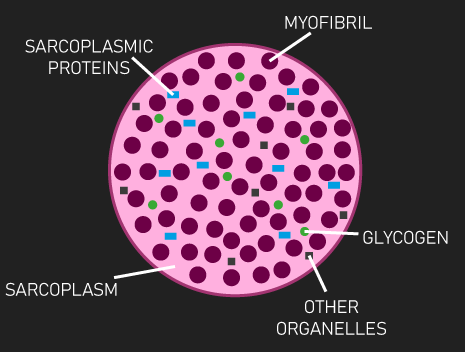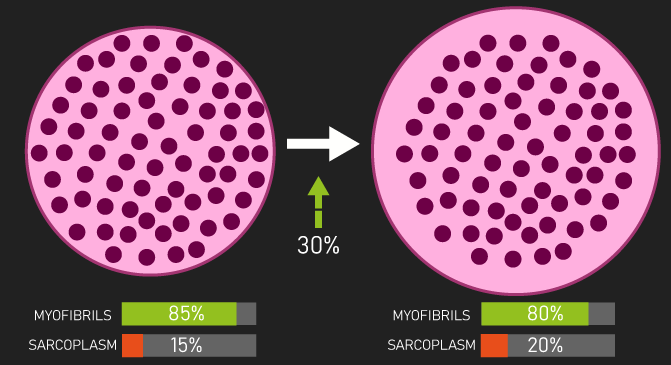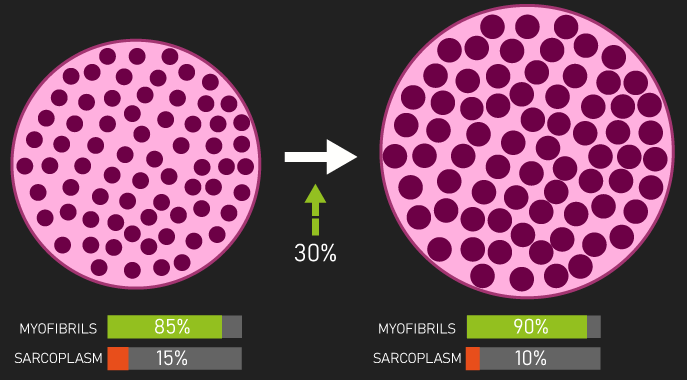
In the fitness world, sarcoplasmic hypertrophy seems to be quite controversial.
However, as we saw in a previous article (and as we’ll review in a moment), sarcoplasmic hypertrophy does indeed seem to be real, there are studies supporting the existence of it.
Table of Contents
What is Sarcoplasmic Hypertrophy?
Before we go any deeper, it’s first helpful to ensure we are all on the same page as to what sarcoplasmic hypertrophy actually is.
Firstly, we need to understand muscles are organized in hierarchical layers.

Within whole muscles are fascicles, within fascicles are muscle fibers, and within muscle fibers are myofibrils.
Myofibrils are where the magic of muscle contraction occurs, they contain an array of sarcomeres.
Sarcomeres are what generate muscle force.
Specifically, when something called the myosin head extends from the myosin filament and pulls on something called the actin filament towards the M-line, force is generated.

B) The myosin heads extend from the myosin filaments and attach to the actin filaments.
C) The myosin filaments pull the actin filaments towards to M-line, shortening the sarcomere length.
To understand sarcoplasmic hypertrophy, we need to step back and take a closer look at the muscle fiber level.
As noted, within muscle fibers are myofibrils.
Everything else within the muscle fiber can be considered the sarcoplasm.
The sarcoplasm largely consists of water but also contains other components, such as glycogen, sarcoplasmic proteins, and non-contractile organelles (like mitochondria, the sarcoplasmic reticulum, and transverse tubules).

Sarcoplasmic hypertrophy is where the sarcoplasm grows at a greater pace than the myofibrils, meaning that this sarcoplasm growth disproportionately drives the increase in muscle fiber cross-sectional area.

As an extra note, myofibrillar hypertrophy is where the myofibrils and sarcoplasm expand at the same rate, while myofibrillar packing is where the myofibrils expand at a greater rate than the sarcoplasm


Can You Train For Sarcoplasmic Hypertrophy?
Direct Research
In a previous article, we examined the training variables used in studies that found evidence for myofibrillar hypertrophy, sarcoplasmic hypertrophy, and myofibrillar packing in hope of finding out if there are specific ways you can train for either.
As we saw, in nearly all of the studies that found evidence for either of these types of muscle fiber growth, moderate loads and moderate frequencies were used.

On the other hand, volume may be the differentiating factor.
More precisely, low to moderate volumes were associated with myofibrillar hypertrophy or myofibrillar packing, while high volumes were associated with sarcoplasmic hypertrophy.
Below depicts the long-term studies finding evidence for sarcoplasmic hypertrophy. As is evident, 3/5 of the studies can be classified as using high volumes.

Now, as we alluded to in the original article, by no means is this overwhelming or definitive evidence.
Future research will be of great value for providing clarity of whether sarcoplasmic hypertrophy is truly best elicited through high volumes.
Nonetheless, for the time being, I think the interpretation that high volumes may make sarcoplasmic hypertrophy more likely is fair.
Furthermore, as we’ll establish in a moment, there is a logical rationale behind why high volumes may preferentially stimulate sarcoplasmic hypertrophy.
As for loading, the overwhelming majority of studies in this area have used moderate loads, and as we saw, this loading produced all three types of muscle fiber growth.
Thus, the current evidence is insufficient to inform us if light loads or heavy loads can preferentially induce sarcoplasmic hypertrophy, myofibrillar packing, or myofibrillar hypertrophy.
Hopefully future research can clear this up.
What Causes the Sarcoplasmic to Expand?
Let us now explore what, on the ultrastructural level, may drive sarcoplasmic hypertrophy.
To phrase this another way, we know sarcoplasmic hypertrophy is where the sarcoplasm grows disproportionately more than the myofibrils.
But, what may primarily drive this disproportionately greater sarcoplasm growth?
Some key contenders include:
An increase in glycogen
An Increase in creatine phosphate
An Increase in mitochondria
An Increase in volume of the sarcoplasmic reticulum
An Increase in volume of transverse tubules
Or an increase in sarcoplasmic proteins
Plausibly, any of these could independently or collectively drive disproportionate sarcoplasm growth.
Let us evaluate them.
Sarcoplasmic Reticulum & Transverse Tubules
Firstly, the sarcoplasmic reticulum and transverse tubules are organelles within muscle fibers that play a pivotal role in the events leading up to muscle force production.
Unfortunately, I’m not aware of any research exploring if the volume of the sarcoplasmic reticulum or transverse tubules increases with resistance training. Therefore, we simply do not know if these contribute to sarcoplasmic hypertrophy.
Mitochondria
As for mitochondria, this is an organelle found within muscle fibers (and other cells in the human body) that generate chemical energy. However, we can probably rule out an increase in mitochondria contributing to sarcoplasmic hypertrophy.
This is because the majority of the evidence suggests the relative space taken up by mitochondria does not increase, or may even decrease, in response to resistance training.
Glycogen
Glycogen, opposingly, may play a role in sarcoplasmic hypertrophy.
Glycogen are particles that can be viewed as a source of energy for muscle fibers.
Each gram of glycogen is stored with at least 3 grams of water. Therefore, an increase in glycogen within muscle fibers concurrently increases the amount of water within the sarcoplasm, causing sarcoplasm growth.
A study by MacDougall et al. found that after training the triceps for 5 months with high volumes, the relative space taken up by glycogen did increase within triceps muscle fibers. This data suggests that glycogen indeed may be able to disproportionately drive sarcoplasm growth (that is, sarcoplasmic hypertrophy).
However, there is also evidence against this.
Haun et al. found that after 6 weeks of progressing up to high volumes, the relative space taken up by glycogen within vastus lateralis muscle fibers did not increase.
Moreover, it’s also important to note high carbohydrate diets can meaningfully increase the relative space taken up by glycogen within muscle fibers. Also, immediately after hard resistance training, the relative space taken up by glycogen within muscle fibers is meaningfully decreased.
Therefore, if glycogen was to drive sarcoplasmic hypertrophy, this type of growth may be considered somewhat transient and variable.
In total, based on the information we’ve detailed, I think it’s fair to say that it’s not completely clear if glycogen is truly a driver of sarcoplasmic hypertrophy.
Creatine Phosphate
Moving on to creatine phosphate, this is a molecule that plays a role in recycling ATP, which is the primary energy carrier in the body.
It’s believed creatine phosphate (particularly the creatine component) causes an increase in the amount of water within muscle fibers too.
Therefore, an increase in creatine phosphate within muscle fibers may create sarcoplasm growth via a concurrent increase in water.
Returning to the study by MacDougall et al. who had subjects train their triceps for 5 months with high volumes, they also observed an increase in the relative space taken up by creatine phosphate within the triceps muscle fibers.
Therefore, perhaps creatine phosphate may indeed help explain sarcoplasmic hypertrophy.
Now, some of you probably have questions about creatine supplementation. Namely, can creatine supplementation make sarcoplasmic hypertrophy more likely?
It’s important to remember that just because creatine supplementation may increase water within muscle fibers, this itself doesn’t guarantee sarcoplasmic hypertrophy in the long run.
The increase in water within the muscle fiber would have to be relatively greater than any myofibril growth achieved with training to create sarcoplasmic hypertrophy.
However, four studies in which subjects supplemented with creatine monohydrate actually found evidence for myofibrillar packing after training with low volumes for 4 to 10 weeks (one, two, three, and four).
Put differently, the myofibrils expanded at a greater rate than the sarcoplasm, indicating any increase in water elicited by creatine supplementation was insufficient to create sarcoplasmic hypertrophy.
It’s worth emphasizing again low volumes (less than 10 weekly sets for a muscle group) were used in these four studies.
As we know, perhaps higher volumes (21 or more weekly sets for a muscle group) are what creates sarcoplasmic hypertrophy.
Moreover, recall the study by MacDougall et al. found with higher volumes that elicited sarcoplasmic hypertrophy, there was a significant increase in the relative space taken up by creatine phosphate.
This brings up an interesting question: could supplementing creatine with high volume training accentuate sarcoplasmic hypertrophy in comparison to only training with high volumes without creatine supplementation.
Unfortunately, there’s no research exploring this, so we cannot make any conclusions.
Sarcoplasmic Proteins
Anyway, progressing on to sarcoplasmic proteins, could an increase in sarcoplasmic proteins also play a role in sarcoplasmic hypertrophy?
Sarcoplasmic proteins are involved in various chemical reactions within muscle fibers.
Assuming sarcoplasmic proteins are dissolved in the sarcoplasm, an increase in them could drive water within the muscle fiber, thereby growing the sarcoplasm.
In a study by Haun et al., in which sarcoplasmic hypertrophy was observed after 6 weeks of progressing to high volumes, the relative space taken up by sarcoplasmic proteins tended to increase.
I should mention that many of the sarcoplasmic proteins that increased were involved in anaerobic glycolysis, a point that becomes noteworthy later on.
As a result, this study perhaps suggests an increase in sarcoplasmic proteins was contributing to the disproportionate sarcoplasm growth.
Now, I should mention that there was a study by Vann et al. who observed evidence for sarcoplasmic hypertrophy, but found the relative space taken up by sarcoplasmic proteins did not increase.
However, the thing is the Vann et al. study did not use high volumes, subjects in their study only performed 12-16 weekly sets for the quadriceps.
Returning to the list of studies that found sarcoplasmic hypertrophy, we can see that it was one of two studies that did not use high volumes, yet found sarcoplasmic hypertrophy.

In the article where we originally explored this research, I described why the other study by Penman should be viewed with caution. No statistical analyses were performed, and no fiber or whole muscle growth measurement was given.
Therefore, when ignoring the Penman study, the study by Vann et al. may currently be considered somewhat an outlier.
Furthermore, comparing this study to the Haun et al. study, which progressively worked up to higher volumes and found an increase in sarcoplasmic proteins, the magnitude of sarcoplasmic hypertrophy was much greater in the Haun et al. study.
Small Summary
To conclude this section on what may cause the sarcoplasm to disproportionately grow, the current evidence seems promising that an increase in creatine phosphate and sarcoplasmic proteins may be involved.
Before moving on, if you’re curious about creating an effective training program for muscle hypertrophy, our high quality partner Alpha Progression can help. It can generate a highly effective program for you, track your workouts live with in-built progression recommendations, provide graphs displaying your long term progress, and it has a massive exercise database with more than 550 exercises.
Click HERE (the link opens in a new tab) to get a free 2 week trial of the apps features. If you like it and go beyond, the link also gives you 20% off a subscription!
We never promote trash at the House of Hypertrophy, so rest assured the app is high quality. The reviews speak to this, 4.8 starts (based on more than 7,000 reviews) on Google play, and 4.9 stars in Apple’s store (based on nearly 400 ratings).
Why Would Sarcoplasmic Hypertrophy Occur?
Let us move on to the interesting question of why sarcoplasmic hypertrophy may even occur in the first place.
Put differently, what would be the body’s reason for growing the sarcoplasm disproportionately more than the myofibrils?
There are a few potential candidate scenarios, a few of these were mentioned in a fascinating review study by Haun et al.
Result of High Volume Training
The first one suggests that sarcoplasmic hypertrophy is a response to high-volume training (that is, a large number of weekly sets for your muscle groups).
As we know, there have been 5 long-term studies finding sarcoplasmic hypertrophy, and 3 of these used high volumes.
Combine these findings with the findings that disproportionate sarcoplasm growth may be driven by an increase in creatine phosphate and sarcoplasmic proteins, we arrive at a very interesting potential mechanistic rationale.
Specifically, it makes sense that high-volume training may cause sarcoplasmic hypertrophy through significant increases in creatine phosphate and sarcoplasmic proteins.
Let me explain.
Most people’s sets with any given exercise last far less than 2 minutes.
During this time, 2 energy systems would primarily be used.
The first one is where creatine phosphate creates energy for muscle contraction (which probably lasts 5-10 seconds), while the second one is anaerobic glycolysis, where glucose is used to create energy for muscle contraction (which probably lasts up to 2 minutes).
Now, regardless of whether you perform a high number or a low number of sets for a given exercise, you’re using both these energy systems.
However, with higher volumes (that is, a high number of sets), you’re taxing these energy systems more. In other words, you are using these energy systems and replenishing them (during the rest intervals) to a greater extent than using lower volumes.
Therefore, it’s logical that high volume training would provoke a significant increase in creatine phosphate and sarcoplasmic proteins involved in anaerobic glycolysis.
Now, it’s important I mention that this is currently just my hypothesis, I believe the mentioned logic makes sense based on the current data, but please remember it is far from a definitive conclusion. Future research could very well provide evidence that renders this hypothesis obsolete.
Swelling
Moving on, the second scenario behind why sarcoplasmic hypertrophy may occur is something novel we haven’t addressed at all in this video but is very reasonable.
It suggests sarcoplasmic hypertrophy may be merely swelling and nothing else.
To expand on this, in response to exercise that elicits high degrees of damage, muscle fibers can swell.
This swelling is a build-up of water within muscle fibers and thus technically fits the definition of sarcoplasmic hypertrophy.
As an example of this, a study by Yu et al. had sedentary men run down a staircase for 10 floors. They took an elevator back up and repeated this 15 times.
This protocol was likely highly damaging.
Firstly, the workload used was quite substantial for the untrained subjects.
Secondly, running downstairs results in eccentric contractions of many lower body muscles, including the soleus (one of the calf muscles).
Eccentric contractions are where your muscles produce force while lengthening. These types of contractions are highly damaging when you’re unaccustomed to them.
What the researchers found was that 7-8 days after the session, the cross-sectional area of muscle fibers from the soleus was inflated by 30%.
The authors suggested, and I would agree, that this increase in muscle fiber size was due to the build-up of fluid from swelling.
Now, swelling is only temporary, it eventually subsides.
Even so, we know the majority of the long-term studies that find evidence for sarcoplasmic hypertrophy used high volumes.
High volumes can be quite damaging, and thus one could argue that maybe the results are simply a reflection of swelling.
However, there are problems with this suggestion.
Firstly, in the Haun et al. study, recall their data potentially implies that an increase in sarcoplasmic proteins was at least partially driving sarcoplasmic hypertrophy. This is independent of swelling.
Secondly, one of the studies by MacDougall et al. lasted 5 months. It’s generally thought that the amount of swelling induced by training gradually diminishes as you continue training with the same program. Additionally, they took their measurements 4-6 days after the final training session, a time point at which swelling is made further unlikely. So in total, it’s hard to believe swelling was what explained this study’s results.
Thirdly, as we saw in a previous article, there are two cross-sectional studies that find potential evidence for sarcoplasmic hypertrophy in bodybuilders and powerlifters with numerous years of previous training experience (detailed below).

Therefore, all in all, the notion that sarcoplasmic hypertrophy is merely swelling is very questionable and I’d argue unlikely.
Sarcoplasm Growth Is Priming
Moving on to the third potential scenario, this one quite fascinatingly suggests that the sarcoplasm grows disproportionately more in order to be primed and prepared for subsequently growing myofibrils.
In other words, sarcoplasmic hypertrophy is just a precursor to myofibrillar hypertrophy or even myofibrillar packing.
The question here is why couldn’t the myofibrils just significantly grow, why must the sarcoplasm grow disproportionately more first?
The potential answer to this is that growing myofibrils not only requires a lot of space but is also an energetically costly process.
By increasing the number of components within a muscle fiber that are involved in generating energy, such as sarcoplasmic proteins (which go on to cause sarcoplasm growth), not only is there more space for myofibrils to grow into, but the whole process of growing myofibrils would become much energetically easier for the muscle fiber.
Overall, this is a very interesting and elegant hypothesis. However, at this time, I don’t believe there’s any strong evidence for or against it.
Now, this whole scenario could be related to the previous scenario of sarcoplasmic hypertrophy being a response to high volume training.
High-volume training may actually be effective for growing myofibrils and ultimately causing myofibrillar hypertrophy or even myofibrillar packing.
It’s just that first the body produces sarcoplasmic hypertrophy (via an increase in energy generating components) to not only deal with the taxing high volume training but also prepare the fibers spatially and energetically for growing myofibrils.
Again, It’s important I mention this is just a hypothesis, I believe the current evidence is far from strong enough to verify or falsify it.
Myofibril Size Threshold
Finally, the fourth potential scenario as to why the body produces sarcoplasmic hypertrophy relates to reaching a potential threshold in the size of myofibrils.
It suggests that muscle fibers significantly grow myofibrils up until a point, we’ll call this point the myofibril size threshold.
From here, growing myofibrils further becomes significantly more spatially and energetically challenging for the fiber.
Consequently, sarcoplasmic hypertrophy occurs via an increase in energy-producing components, like sarcoplasmic proteins, thereby making future growth of the myofibrils easier.
Now, there is potentially some supporting evidence for this.
Returning to the long-term studies that found evidence for sarcoplasmic hypertrophy, two of them (the studies by Haun and Vann) were conducted on trained individuals.

Perhaps the subjects of these studies had reached their myofibril size thresholds, explaining why they experienced sarcoplasmic hypertrophy.
However, the obvious problem here is that the three other studies that found evidence for sarcoplasmic hypertrophy were conducted on untrained men, who would presumably not be near their myofibril size threshold.
Therefore, I’d say the current evidence is probably leaning away from the idea that sarcoplasmic hypertrophy is a result of reaching a myofibril size threshold.
Small Summary
To summarize this section of the article, the idea that sarcoplasmic hypertrophy is merely swelling or that sarcoplasmic hypertrophy is a result of reaching a myofibril size threshold seems unlikely based on the current evidence.
On the other hand, the evidence is promising that sarcoplasmic hypertrophy may be a result of training with high volumes. Furthermore, although very speculative at this time, perhaps this is also related to the notion that sarcoplasmic hypertrophy is essentially spatial and energetic priming for subsequent myofibril growth.
The Role of Anabolic Steroids
To close out this article, I think a discussion on the potential role of anabolic steroids on sarcoplasmic hypertrophy would be interesting.
Specifically, could taking anabolic steroids increase the likelihood you experience sarcoplasmic hypertrophy?
There is indeed some evidence to support this.
For those who’ve seen our previous article exploring the research on the 3 types of muscle fiber growth, you’ll know that there were two cross-sectional studies finding potential evidence for sarcoplasmic hypertrophy.
Specifically, a study by MacDougall et al. found that compared to 5 untrained men, the muscle samples of 7 well-trained lifters had more relative space taken up by the sarcoplasm, potentially implying the well-trained lifters experienced sarcoplasmic hypertrophy.
Similarly, a study by Meijer et al. found that the muscle fibers of 12 bodybuilders had a lower specific tension value compared to 6 power athletes and 14 untrained men, also potentially implying the bodybuilders experienced sarcoplasmic hypertrophy.
In the MacDougall et al. study, 6 out of 7 of the well-trained lifters were using or had previously used anabolic steroids.
In the Meijer et al. study, 9 out of 12 of the bodybuilders were reported to be using anabolic steroids.
Therefore, perhaps this indicates anabolic steroids may make sarcoplasmic hypertrophy likely.
Having said this, there is also evidence against this.
In the Meijer et al. study itself, 3 out of 12 bodybuilders were not on steroids, yet their specific tension was still lower than the power athletes and untrained men, suggesting these natural bodybuilders equivalently experienced sarcoplasmic hypertrophy.
Furthermore, a different study by D’Antionia et al. found that compared to untrained men, 2 bodybuilders on anabolic steroids had higher specific tension of their muscle fibers. This higher specific tension indicates the bodybuilders may have actually experienced myofibrillar packing.
Therefore, based on the current evidence, it’s hard to know what role, if any, anabolic steroids may play in sarcoplasmic hypertrophy.
Takeaway
Let us aim to summarize the whole article into a few takeaway points.
Before mentioning them, it’s again essential to recognize that all the following points are by no means definitive conclusions, rather they are based on interpretations of the current evidence. Future research could most definitely change them.
- You could potentially train for sarcoplasmic hypertrophy. More precisely, it seems using high volumes (defined as training a muscle with 21 or more weekly sets) may make sarcoplasmic hypertrophy more likely.
- This may be related to the fact that high volumes, due to being more taxing on creatine phosphate and anaerobic glycolysis energy systems, elicit a significant increase in creatine phosphate and sarcoplasmic proteins involved in glycolysis. Both of these can contribute to disproportionate sarcoplasm growth.
- A very interesting yet very speculative hypothesis suggests that not only is sarcoplasmic hypertrophy produced to deal with the high volume training, but it also may prime the muscle fiber spatially and energetically for significantly growing myofibrils. Essentially meaning that perhaps high-volume training ultimately causes myofibrillar hypertrophy or even myofibrillar packing.
Remember to feel free to check out the Alpha Progression App if you’re interested. Also feel free to check out our free bench press e-book below.

